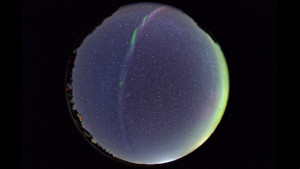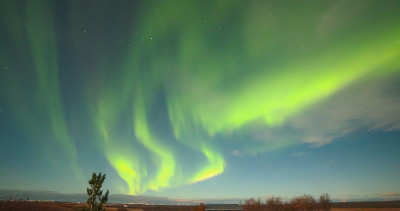Glossary term: 极光
Description: 极光是地球大气中呈现的弥散的多变彩色光,主要出现在极地地区。在北半球被称为北极光或极光,在南半球则称为南极光。极光的颜色从绿白色到红色,通常出现在大约100公里的高度,形成围绕地磁极的两个不规则极光椭圆。当来自太阳风或日冕物质抛射的带电粒子被地球磁层捕获,并被上层大气中的磁场集中到一起时,它们会沿着地球的磁场线向极地螺旋运动。带电粒子与大气中的原子和分子相互作用,产生极光的光芒。这种现象在太阳活动强烈时尤为显著。极光还在太阳系的其他行星上被也会被观测到,特别是在木星和土星上。
Related Terms:
See this term in other languages
Term and definition status: The original definition of this term in English have been approved by a research astronomer and a teacher The translation of this term and its definition is still awaiting approval
The OAE Multilingual Glossary is a project of the IAU Office of Astronomy for Education (OAE) in collaboration with the IAU Office of Astronomy Outreach (OAO). The terms and definitions were chosen, written and reviewed by a collective effort from the OAE, the OAE Centers and Nodes, the OAE National Astronomy Education Coordinators (NAECs) and other volunteers. You can find a full list of credits here. All glossary terms and their definitions are released under a Creative Commons CC BY-4.0 license and should be credited to "IAU OAE".
If you notice a factual or translation error in this glossary term or definition then please get in touch.
Related Media
直到世界尽头,作者Hang Li,中国
Credit: Hang Li/IAU OAE
License: CC-BY-4.0 Creative Commons 署名 4.0 国际 (CC BY 4.0) icons
《星空下的Steve》,由加拿大 Sheila Wiwchar 拍摄。
Credit: Wiwchar, Sheila; IAU OAE
License: CC-BY-4.0 Creative Commons 署名 4.0 国际 (CC BY 4.0) icons
西班牙塞尔吉奥·迪亚兹·鲁伊斯拍摄的《冰岛光之河》。
Credit: Sergio Díaz Ruiz/IAU OAE
License: CC-BY-4.0 Creative Commons 署名 4.0 国际 (CC BY 4.0) icons
意大利科尔蒂纳天文协会代表马尔科·米利亚尔迪拍摄的冰岛多彩极光。
Credit: 马尔科·米利亚尔迪代表科尔蒂纳天文协会/IAU OAE。
License: CC-BY-4.0 Creative Commons 署名 4.0 国际 (CC BY 4.0) icons
北极光龙盘旋于挪威埃尔斯峡湾上空
Credit: Rainer Sparenberg/IAU OAE
License: CC-BY-4.0 Creative Commons 署名 4.0 国际 (CC BY 4.0) icons













